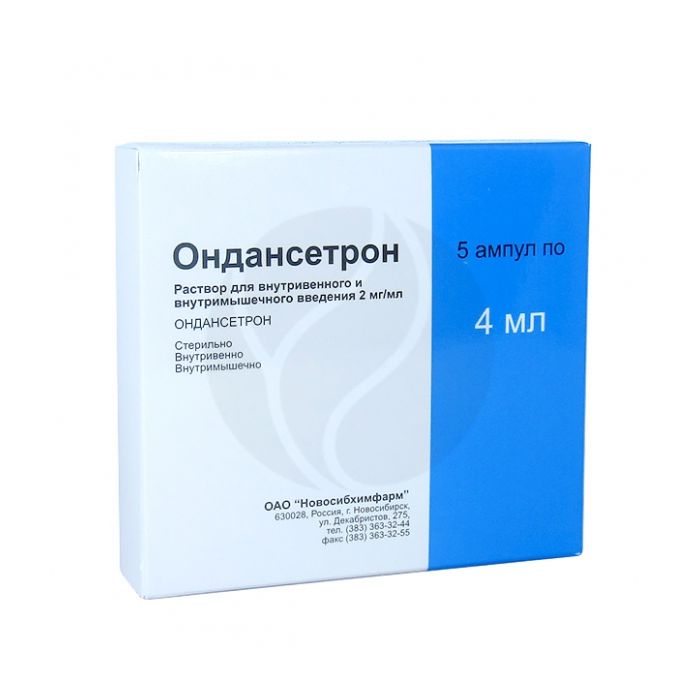Ondansetron solution for injection 2mg / ml, 4ml No. 5
Expiration Date: 11/2025
Russian Pharmacy name:
Ондансетрон раствор для инъекций 2мг/мл, 4мл №5
Prevention of nausea and vomiting during anticancer chemotherapy or radiation therapy;
prevention and treatment of nausea and vomiting in the postoperative period.
Ondansetron is administered intravenously (infusion), intramuscularly.
Adults with moderate emetogenic chemotherapy and radiation therapy initially: 8 mg, once intravenously slowly immediately before the start of the course and again after 8-12 hours; adults and adolescents 12 years and older can be administered by infusion over 15 minutes - 32 mg once 30 minutes before the start of the course or 0.15 mg / kg 3 times - 30 minutes before the start of chemotherapy and then after 4 and 8 hours.
Solution for intravenous and intramuscular administration is colorless or colored, transparent.
1 ml
ondansetron hydrochloride dihydrate 2.49mg, which corresponds to the content of ondansetron 2 mg
Excipients: sodium chloride - 9 mg, anhydrous citric acid - 0.46 mg, sodium citrate dihydrate - 0.31 mg, water d / i - up to 1 ml.
I trimester of pregnancy,
hypersensitivity to ondansetron.
pharmachologic effect
Antiemetic. Effectively prevents and eliminates nausea and vomiting that occur during anticancer chemotherapy or radiation therapy, as well as in the postoperative period. The mechanism of action is due to the ability of ondansetron to selectively block serotonin 5-HT3 receptors. It is believed that stimulation of afferent fibers of the vagus nerve with serotonin released from enterochromaffin cells of the gastrointestinal mucosa plays an important role in the occurrence of nausea and vomiting during antitumor therapy. By blocking 5-HT3 receptors, ondansetron prevents the onset of the gag reflex. In addition, ondansetron inhibits the central links of the gag reflex by blocking 5-HT3 receptors in the floor of the IV ventricle (area postrema).
Pharmacokinetics
After oral administration, ondansetron is well absorbed from the gastrointestinal tract. Undergoes a 'first pass' effect through the liver. Protein binding is high (70-76%). Biotransformed in the liver, mainly by hydroxylation. The average T1 / 2 in adult patients is about 4 hours. In case of impaired liver function, an increase in T1 / 2 is noted.
Side effect
From the side of the central nervous system: headaches; rarely - transient visual impairment and dizziness (with rapid intravenous injection), involuntary movements.
From the side of the cardiovascular system: rarely - chest pain, arrhythmias, bradycardia, arterial hypotension.
From the digestive system: constipation, diarrhea, abdominal pain, transient increase in serum transaminase levels.
Allergic reactions: rarely - bronchospasm, angioedema, urticaria; in some cases - anaphylactic reactions.
Others: feeling of warmth and rush of blood to the head and epigastric region.
Application during pregnancy and lactation
Ondansetron is contraindicated for use in the first trimester of pregnancy. If necessary, use during lactation should stop breastfeeding.
Application for violations of liver function
When used in patients with moderate and severe hepatic dysfunction, it is not recommended to exceed the dose of 8 mg / day.
special instructions
When used in patients with moderate and severe hepatic dysfunction, it is not recommended to exceed the dose of 8 mg / day.
Ondansetron is used with caution during abdominal surgery, because its use can mask progressive intestinal obstruction.
Drug interactions
Due to the fact that ondansetron is metabolized in the liver by isoenzymes of the cytochrome P450 system, with simultaneous use with drugs that are inducers or inhibitors of this enzyme system, changes in clearance and T1 / 2 of ondansetron are possible.

